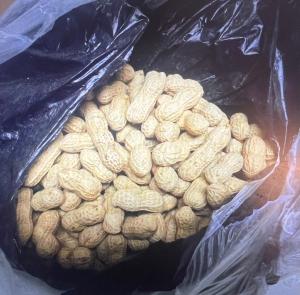Tulsa CBP seizes potentially harmful agricultural products from Asia
Tulsa CBP seizes potentially harmful agricultural products from Asia Customs and Border Protection


TULSA, Okla.
Agriculture Specialists from U.S. Customs and Border Protection recently seized several products that could have potentially caused an animal disease or pest infestation outbreak of had they been allowed into the United States.
Prohibited Product: Edible Birds’ Nests
The first of two products involved a shipment was labeled and manifested as jewelry but contained a box of edible birds’ nests that weighed 1.2 kilograms. Edible birds’ nests are prohibited due to Highly Pathogenic Avian Influenza (HPAI) and Newcastle Disease (ND) – common for the Asia region. A U.S. Department of Agriculture veterinary service permit and/or certificate from a veterinarian is required to negate the possible introduction of these diseases into the United States. This prohibited product was destroyed by steam sterilization following its discovery by CBP.
Prohibited Product: Raw Unshelled Peanuts
The second seizure involved peanuts labeled and manifested as cotton t-shirts. After a CBP inspection, raw unshelled peanuts weighing 9.2 kilograms were discovered. Raw and unroasted peanuts without a permit and/or a phytosanitary certificate are prohibited for the potential introduction of foreign pests, noxious weeds, and plant diseases. No paperwork accompanied the shipment. The prohibited item in the shipment was destroyed by steam sterilization following discovery by CBP.
CBP Agriculture Specialists
CBP agriculture specialists have extensive training and experience in the biological sciences and agricultural inspection. On a typical day nationally last year, they inspected almost 1 million people as well as air and sea cargo imported to the United States, intercepting 240 different pests and 2,677 quarantine material interceptions such as plant, meat, animal byproduct, and soil at U.S. ports of entry.
Sustainable Development Goals (SDGs)
- Goal 2: Zero Hunger – Preventing the introduction of harmful products helps protect agricultural resources and ensures food security.
- Goal 3: Good Health and Well-being – Avoiding the outbreak of deadly diseases protects public health.
- Goal 15: Life on Land – Intercepting pests and preventing the introduction of invasive species helps preserve biodiversity and ecosystems.
“CBP agriculture specialists protect our nation’s ag industry and the economy and way of life of the American people,” said CBP Tulsa Port Director Al Coates. “These efforts are critical in preventing the outbreak of deadly diseases in the United States, which could result in health and economic calamity.”
SDGs, Targets, and Indicators
1. SDGs Addressed or Connected to the Issues Highlighted in the Article:
- SDG 2: Zero Hunger
- SDG 3: Good Health and Well-being
- SDG 15: Life on Land
2. Specific Targets Based on the Article’s Content:
- Target 2.4: By 2030, ensure sustainable food production systems and implement resilient agricultural practices that increase productivity and production, that help maintain ecosystems, that strengthen capacity for adaptation to climate change, extreme weather, drought, flooding, and other disasters, and that progressively improve land and soil quality.
- Target 3.3: By 2030, end the epidemics of AIDS, tuberculosis, malaria, and neglected tropical diseases and combat hepatitis, water-borne diseases, and other communicable diseases.
- Target 15.8: By 2020, introduce measures to prevent the introduction and significantly reduce the impact of invasive alien species on land and water ecosystems and control or eradicate the priority species.
3. Indicators Mentioned or Implied in the Article:
- Indicator 2.4.1: Proportion of agricultural area under productive and sustainable agriculture.
- Indicator 3.3.1: Number of new HIV infections per 1,000 uninfected population, by sex, age, and key populations.
- Indicator 15.8.1: Proportion of countries adopting relevant national legislation and adequately resourcing the prevention or control of invasive alien species.
Table: SDGs, Targets, and Indicators
| SDGs | Targets | Indicators |
|---|---|---|
| SDG 2: Zero Hunger | Target 2.4: By 2030, ensure sustainable food production systems and implement resilient agricultural practices that increase productivity and production, that help maintain ecosystems, that strengthen capacity for adaptation to climate change, extreme weather, drought, flooding, and other disasters, and that progressively improve land and soil quality. | Indicator 2.4.1: Proportion of agricultural area under productive and sustainable agriculture. |
| SDG 3: Good Health and Well-being | Target 3.3: By 2030, end the epidemics of AIDS, tuberculosis, malaria, and neglected tropical diseases and combat hepatitis, water-borne diseases, and other communicable diseases. | Indicator 3.3.1: Number of new HIV infections per 1,000 uninfected population, by sex, age, and key populations. |
| SDG 15: Life on Land | Target 15.8: By 2020, introduce measures to prevent the introduction and significantly reduce the impact of invasive alien species on land and water ecosystems and control or eradicate the priority species. | Indicator 15.8.1: Proportion of countries adopting relevant national legislation and adequately resourcing the prevention or control of invasive alien species. |
Based on the article, the issues highlighted are connected to SDG 2 (Zero Hunger) as it discusses the interception of prohibited food products that could potentially introduce diseases and pests. SDG 3 (Good Health and Well-being) is also relevant as it emphasizes preventing the outbreak of deadly diseases. Additionally, SDG 15 (Life on Land) is connected as it focuses on preventing the introduction and impact of invasive alien species on ecosystems.
The specific targets identified from the article’s content include Target 2.4, which aims to ensure sustainable food production systems and resilient agricultural practices, and Target 3.3, which aims to end epidemics and combat communicable diseases. Target 15.8 is also relevant, as it aims to prevent the introduction and reduce the impact of invasive alien species.
The indicators mentioned or implied in the article that can be used to measure progress towards the identified targets are Indicator 2.4.1, which measures the proportion of agricultural area under sustainable agriculture, Indicator 3.3.1, which measures the number of new HIV infections, and Indicator 15.8.1, which measures the proportion of countries adopting legislation for invasive alien species prevention or control.
Behold! This splendid article springs forth from the wellspring of knowledge, shaped by a wondrous proprietary AI technology that delved into a vast ocean of data, illuminating the path towards the Sustainable Development Goals. Remember that all rights are reserved by SDG Investors LLC, empowering us to champion progress together.
Source: cbp.gov

Join us, as fellow seekers of change, on a transformative journey at https://sdgtalks.ai/welcome, where you can become a member and actively contribute to shaping a brighter future.









